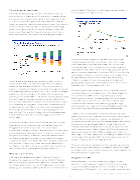Economic_2017.pdf
Tighter nancial conditions
Financial markets’ strong reaction to the election net out
to a tightening in nancial conditions, which if sustained as anticipated, will ding economic growth next year (see Chart 2). It will still be a very good year, as President Trump will inherit an economy that is fundamentally strong. Job creation is robust, the economy is near full employment, and wage growth is accelerating. With a record number of open job positions and few layoffs, it would take a severe shock to derail the economy. But it won’t be quite as good a year.
2
Higher stock prices are a clear plus for growth, primarily
via the wealth effect on consumer spending. Household stockholdings are worth about $1 trillion more since the election. If sustained, that should prompt more spending and be a meaningful add to growth in 2017. But this will be largely washed out by the stronger U.S. dollar and the resulting widening in the trade de cit. The higher interest rates will also bite. With xed mortgage rates back over 4%, re nancing activity has already been curtailed, since the average coupon on outstanding mortgages is close to 4%. Home sales and house prices will also feel it, as more trade-up buyers will have to pay a higher rate on their new mortgage than on
their old one. This is a big change, since homebuyers have enjoyed more-or-less declining mortgage rates since the early 1980s.
Other potential near-term fallout from the election includes heightened policy uncertainty as the new administration struggles to articulate its policies. This could cause businesses to delay investment and perhaps hiring decisions, and consumers will pause (at least for a while) to see how things are proceeding. However, consumer and business con dence may get a lift given the prospects for change. Judging from recently stronger sentiment surveys, frustration over gridlock in Washington may have been weighing on con dence. It is hard to know the upshot of all this, but it is likely these cross-currents will eventually cancel out.
More cyclical economy
Like nancial markets, we expect President Trump to implement an expansionary scal policy of de cit- nanced tax cuts and greater government spending. This will result
in stronger growth over the next 2-3 years as the stimulus ramps up, but weaker growth by the end of his term when the
stimulus fades. There will thus be bigger ups and downs in the business cycle (see Chart 3).
3
The expected tax cuts will not be nearly as large as Mr. Trump proposed during the campaign, but the price tag
is still expected to be sizable at close to $1 trillion over
the next decade. This includes cuts to both personal and corporate income taxes. Government spending also seems set to increase substantially, by at least $500 billion over the next decade. This will include more government spending on veterans’ bene ts and the military, and while more infrastructure spending is not as sure given skepticism among some congressional Republicans around the costs, President-elect Trump appears all-in on it.
Economic growth should peak by mid-2018, when the tax cutting and spending increases are in full swing. Negating the economic bene t of the Trump stimulus is the full- employment economy. The tax and spending multipliers— the growth due to the stimulus—are much smaller than they would be if the economy was struggling with high unemployment, as it was in the Great Recession when the highly effective 2009 Recovery Act was implemented.
Indeed, in a full-employment economy, the expansionary scal policy is quickly crowded out by a less accommodative Federal Reserve and global investors, so-called bond vigilantes, who push up long-term interest rates in anticipation of more in ation and bigger de cits. Higher in ation and interest rates are indeed part of our baseline scenario, with core consumer price in ation breaching 3% on a sustained basis, well above the Fed’s in ation target (see Chart 4 on next page). The Fed responds by increasing the federal funds rate to nearly 4% by early 2020, and the vigilantes push the 10-year Treasury yield to as high as 4.5%.
These are the classic symptoms of an overheating economy, which have historically ended in recession. We do not expect a recession, but the economy comes unnervingly close by the end of President Trump’s term.
2% growth, not 4%
While President Trump will mean big changes for the economy, his policies aren’t expected to materially change long-term growth prospects. Prior to the election, long-run potential real GDP growth―that rate of growth consistent with
3
©2017 Credit Research Foundation
